
Chowder is a thick soup prepared with milk or cream, a roux, and seafood or vegetables. Oyster crackers or saltines may accompany chowders as a side item, and cracker pieces may be dropped atop the dish. New England clam chowder is typically made with chopped clams and diced potatoes, in a mixed cream and milk base, often with a small amount of butter. Other common chowders include seafood chowder, which includes fish, clams, and many other types of shellfish; lamb or veal chowder made with barley; corn chowder, which uses corn instead of clams; a wide variety of fish chowders; and potato chowder, which is often made with cheese. Fish, corn and clam chowder are popular in North America, especially New England and Atlantic Canada.

Clam is a common name for several kinds of bivalve molluscs. The word is often applied only to those that are edible and live as infauna, spending most of their lives halfway buried in the sand of the seafloor or riverbeds. Clams have two shells of equal size connected by two adductor muscles and have a powerful burrowing foot. They live in both freshwater and marine environments; in salt water they prefer to burrow down into the mud and the turbidity of the water required varies with species and location; the greatest diversity of these is in North America.

The Pacific geoduck is a species of very large saltwater clam in the family Hiatellidae. The common name is derived from the Lushootseed (Nisqually) word gʷídəq.
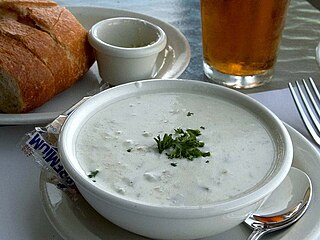
Clam chowder is any of several chowder soups in American cuisine containing clams. In addition to clams, common ingredients include diced potatoes, salt pork, and onions. Other vegetables are not typically used. It is believed that clams were used in chowder because of the relative ease of harvesting them. Clam chowder is usually served with saltine crackers or small, hexagonal oyster crackers.
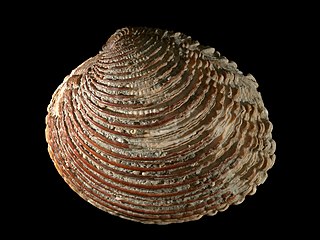
The Veneridae or venerids, common name: Venus clams, are a very large family of minute to large, saltwater clams, marine bivalve molluscs. Over 500 living species of venerid bivalves are known, most of which are edible, and many of which are exploited as food sources.
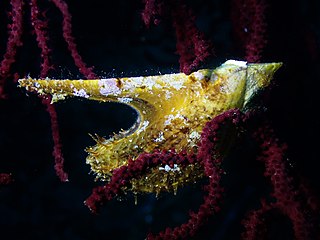
Pteriidae, also called the feather oysters, is a family of medium-sized to large saltwater clams. They are pearl oysters, marine bivalve molluscs in the order Pteriida.
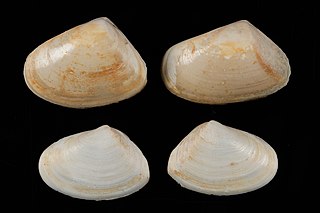
Paphies subtriangulata is a species of edible bivalve clam known as tuatua in the Māori language, a member of the family Mesodesmatidae and endemic to New Zealand. It is found on all three of the main New Zealand islands, buried in fine clean sand on ocean beaches.

Paphies is a genus of large, edible, saltwater clams, marine bivalve molluscs in the family Mesodesmatidae. The genus is endemic to New Zealand. The species in this genus include the pipi, tuatua and toheroa.
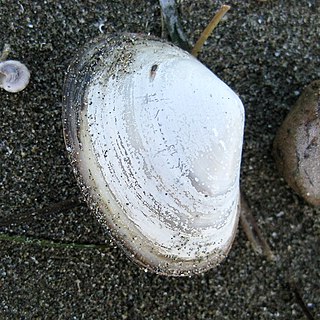
Paphies australis or pipi is a bivalve mollusc of the family Mesodesmatidae, endemic to New Zealand.
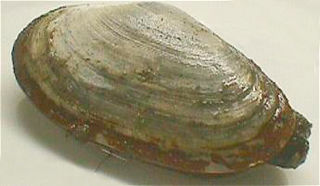
Myida is an order of saltwater and freshwater clams, marine and freshwater bivalve molluscs in the subclass Heterodonta. The order includes such bivalves as soft-shell clams, geoducks and shipworms.
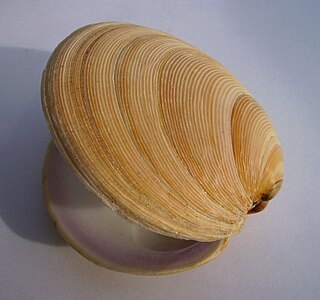
Dosinia anus, commonly named the ringed dosinia, coarse dosinia, coarse biscuit shell and tuangi-haruru, in the Māori language, is a species of saltwater clam, a marine bivalve mollusc in the family Veneridae, the venus clams. The species is common to both of the main islands of New Zealand, where it is the largest and heaviest species in the genus, occasionally exceeding 80 mm in diameter. It buries itself in clean fine sandy substrata, sub-tidally down to 15 m deep.
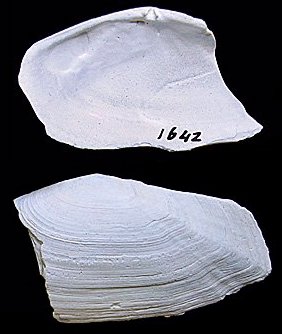
The Psammobiidae, or sunset clams, are a family of medium-sized saltwater clams, marine bivalve molluscs of the order Cardiida.

Barbatia is a genus of "bearded" ark clams, marine bivalve mollusks in the family Arcidae, the ark clams.

Mactridae, common name the trough shells or duck clams, is a family of saltwater clams, marine bivalve mollusks in the order Venerida.
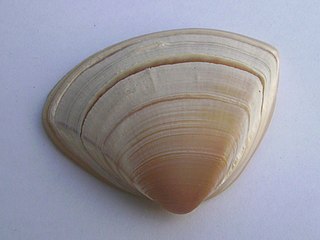
Crassula aequilatera, known as the triangle shell, is a surf clam, a moderately large marine bivalve mollusc in the family Mactridae.
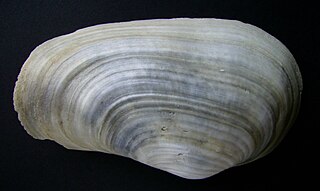
Panopea zelandica, commonly known as the deepwater clam or New Zealand geoduck, is a large species of marine bivalve mollusc in the Panopea (geoduck) genus of the family Hiatellidae. It is also sometimes called a king clam, or a gaper – in reference to the shell not being closed at either end.

Ruditapes largillierti is a saltwater clam, a marine bivalve mollusc in the family Veneridae, the Venus clams. They are moderately large for their genus, elongate and subrectangular, thick and solid, with smooth ventral margin.

"Do The Clam" is a pop song recorded by Elvis Presley for his 1965 feature film Girl Happy. It was written by Sid Wayne, Ben Weisman, and Dolores Fuller.

Austrovenus stutchburyi, common name the New Zealand cockle or New Zealand little neck clam, is an edible saltwater clam, a marine bivalve mollusc in the family Veneridae, the Venus clams. Its Māori name is tuangi or tuaki.

5F-JWH-398 is a recreational designer drug which is classed as a synthetic cannabinoid. It is from the naphthoylindole family, and produces cannabis-like effects. It was legally sold in New Zealand from 2012-2014 under the psychoactive substances scheme but was discontinued in May 2014 following the end of the interim approval period under the Psychoactive Substances Act 2013. Subsequently it has appeared on the illicit market around the world and was identified in Germany in May 2019.



















